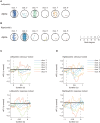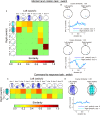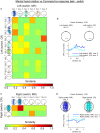Alpha Phase Synchronization of Parietal Areas Reflects Switch-Specific Activity During Mental Rotation: An EEG Study
- PMID: 29977199
- PMCID: PMC6021508
- DOI: 10.3389/fnhum.2018.00259
Alpha Phase Synchronization of Parietal Areas Reflects Switch-Specific Activity During Mental Rotation: An EEG Study
Abstract
Action selection is typically influenced by the history of previously selected actions (the immediate motor history), which is apparent when a selected action is switched from a previously selected one to a new one. This history dependency of the action selection is even observable during a mental hand rotation task. Thus, we hypothesized that the history-dependent interaction of actions might share the same neural mechanisms among different types of action switching tasks. An alternative hypothesis is that the history dependency of the mental hand rotation task might involve a distinctive neural mechanism from the general action selection tasks so that the reported observation with the mental hand rotation task in the previously published literature might lack generality. To refute this possibility, we compared neural activity during action switching in the mental hand rotation with the general action switching task which is triggered by a simple visual stimulus. In the experiment, to focus on temporal changes in whole brain oscillatory activity, we recorded electroencephalographic (EEG) signals while 25 healthy subjects performed the two tasks. For analysis, we examined functional connectivity reflected in EEG phase synchronization and analyzed temporal changes in brain activity when subjects switched from a previously selected action to a new action. Using a clustering-based method to identify functional connectivity reflected in time-varying phase synchronization, we identified alpha-power inter-parietal synchronization that appears only during switching of the selected action, regardless of the hand laterality in the presented image. Moreover, the current study revealed that for both tasks the extent of this alpha-power inter-parietal synchronization was altered by the history of the selected actions. These findings suggest that alpha-power inter-parietal synchronization is engaged as a form of switching-specific functional connectivity, and that switching-related activity is independent of the task paradigm.
Keywords: action switching; dynamic time warping; electroencephalography; functional connectivity; mental rotation; parietal cortex; phase synchronization; weighted phase-lag index.
Figures







Similar articles
-
Brain functional connectivity and the pathophysiology of schizophrenia.Psychiatriki. 2014 Apr-Jun;25(2):91-4. Psychiatriki. 2014. PMID: 25035177 English, Greek, Modern.
-
Temporal changes of beta rhythms and rotation-related negativity reflect switches in motor imagery.Annu Int Conf IEEE Eng Med Biol Soc. 2014;2014:1326-9. doi: 10.1109/EMBC.2014.6943843. Annu Int Conf IEEE Eng Med Biol Soc. 2014. PMID: 25570212
-
Fronto-parietal and fronto-temporal theta phase synchronization for visual and auditory-verbal working memory.Front Psychol. 2014 Mar 18;5:200. doi: 10.3389/fpsyg.2014.00200. eCollection 2014. Front Psychol. 2014. PMID: 24672496 Free PMC article.
-
Brain neural synchronization and functional coupling in Alzheimer's disease as revealed by resting state EEG rhythms.Int J Psychophysiol. 2016 May;103:88-102. doi: 10.1016/j.ijpsycho.2015.02.008. Epub 2015 Feb 7. Int J Psychophysiol. 2016. PMID: 25660305 Review.
-
Dynamic sculpting of brain functional connectivity and mental rotation aptitude.Prog Brain Res. 2006;159:63-76. doi: 10.1016/S0079-6123(06)59005-3. Prog Brain Res. 2006. PMID: 17071224 Review.
Cited by
-
The topology of interpersonal neural network in weak social ties.Sci Rep. 2024 Feb 29;14(1):4961. doi: 10.1038/s41598-024-55495-7. Sci Rep. 2024. PMID: 38418895 Free PMC article.
References
-
- Baayen R. H., Milin P. (2010). Analyzing reaction times. Int. J. Psychol. Res. 3, 12–28. 10.21500/20112084.807 - DOI
-
- Benjamini Y., Hochberg Y. (1995). Controlling the false discovery rate: a practical and powerful approach to multiple testing. J. R. Stat. Soc. 57, 289–300. 10.2307/2346101 - DOI
-
- Caliński T., Harabasz J. (1974). A dendrite method for cluster analysis. Commun. Stat. Theory Methods 3, 1–27. 10.1080/03610927408827101 - DOI
LinkOut - more resources
Full Text Sources
Other Literature Sources

